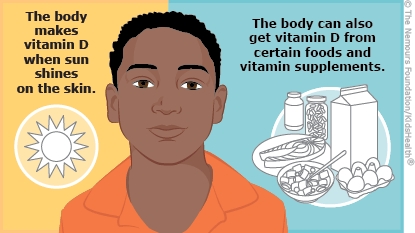Vitamin D is a key nutrient for strong bones and overall health. We get it from the foods we eat, and our bodies also make it when skin is exposed to sunshine.
Vitamin D deficiency is when there's not enough vitamin D in the body. It's treated by increasing the amount of vitamin D in the diet and/or taking supplements by mouth. Sometimes, health care providers recommend letting kids over 6 months old safely expose their skin to sunshine for brief periods.



Your child:

What does vitamin D do? Vitamin D helps the body absorb calcium and phosphorous, two of the basic building blocks of bone. Vitamin D also plays a part in heart health, fighting infection, and helping bones heal after an injury or surgery.
What causes vitamin D deficiency? Vitamin D deficiency can happen in kids who don't get enough vitamin D in their diet, get very little sunlight, have kidney or liver disease, are obese, or have conditions or take medicines that prevent their bodies from absorbing enough vitamin D.
What are the symptoms of vitamin D deficiency? Some kids with vitamin D deficiency (especially if they haven't had it for a long time) don't have any symptoms. When symptoms do happen, they depend on how old the child is. Vitamin D deficiency in babies and children can lead to rickets. Kids with rickets have soft, weak bones. As the bones grow, they can become misshapen and lead to problems such as bone pain and slowed motor (standing, walking) development.
If older kids and teens (whose bones are fully developed) don't get enough vitamin D, their bones can become soft and weak and be more likely to break.